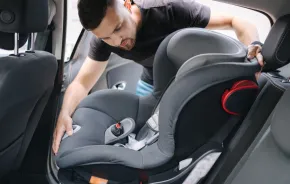
Editor’s note: In this nine-month series we explore how new voluntary standards developed in Washington state are impacting the quality of after-school programs that serve about 134,000 youths after the school bell rings. We will explain what parents should seek in a program, look at research on the impacts of quality care on kids’ development and academics and visit with programs that are successfully serving kids and helping families. After-school Special’s independently reported content is funded by a journalism grant in partnership with the Raikes Foundation and School’s Out Washington. See the full series of articles here.
When Nikeya McAdory picks up her 5-year-old daughter, Dylan, from after-school care at Graham Hill Elementary School in South Seattle, she has a chubby-cheeked 1-year-old in her arms and a 9-year-old son in tow. She has come from her full-time job as a dental assistant downtown; this is her third stop before the family heads to its home in Burien for the evening.

When McAdory gets home, there will be no sharing of responsibilities. She is a single mom covering every base on her own. But there is nothing about McAdory, who has a megawatt smile, that says self-pity. Despite the challenges past and present, her focus is looking forward. “I’m working hard to move up and be a dental hygienist,” she says.
The reality, though, is that McAdory needs help to make it all come together for her family. Kids Co., a nonprofit child care program at Graham Hill and 11 other school locations around the Puget Sound region, offers the family a scholarship each month for both before- and after-school care. Kids Co. helps hundreds of families a year afford child care so that they can keep working. Cofounder Susan Brown says that in the last fiscal year, 95 percent of the single-parented children receiving scholarship support lived in homes headed by single moms.
Far from being just a holding place for kids during non-school hours, Kids Co. is one of hundreds of organizations regularly assessing, planning and improving their programs to ensure that they are of the highest quality. As ParentMap has reported in this series, the tool used by programs to voluntarily assess themselves and improve is called the Youth Program Quality assessment; it was unveiled last spring by School’s Out Washington.
Experts agree that children benefit by being more engaged, not just in their after-school program, but ultimately in their schoolwork as well. “No matter what your income level, every kid needs the same ability to be a kid and dig into their own interests,” Brown says. In its 25 years of operation, Kids Co. has given $1.5 million in scholarship support.
 The School’s Out assessment program also offers a path for improvement to groups that help families with needs beyond child care. Valley Cities provides mental health and teen support services in south King County. On a recent Friday evening, counselor Patrice Cade threw a holiday party for client families at a Federal Way community center. Two dozen adults and kids filled the room with laughter and conversation, almost entirely in Spanish. For parents like Olivia Torres, who works while raising her three young children, playing games and sharing dessert was an early holiday gift. “Sí, yes, being here is good, very good,” says Torres, laughing, as she got some translation help from her 8-year-old daughter.
The School’s Out assessment program also offers a path for improvement to groups that help families with needs beyond child care. Valley Cities provides mental health and teen support services in south King County. On a recent Friday evening, counselor Patrice Cade threw a holiday party for client families at a Federal Way community center. Two dozen adults and kids filled the room with laughter and conversation, almost entirely in Spanish. For parents like Olivia Torres, who works while raising her three young children, playing games and sharing dessert was an early holiday gift. “Sí, yes, being here is good, very good,” says Torres, laughing, as she got some translation help from her 8-year-old daughter.
Single working mothers are disproportionately burdened by poverty, according to data from the Census Bureau’s American Community Survey. In a 2014 policy brief, the Working Poor Families Project reported that since 2007 the economic circumstances of working mothers have deteriorated. The share of female-headed working families that are low-income increased from 54 percent in 2007 to 58 percent in 2012. And while female-headed working families make up 22 percent of all working families, they comprise 39 percent of low-income working families. Finding affordable, accessible child care is often an impediment to career advancement.
During the week of the holiday party, Cade and Valley Cities staff had spent several days assessing each other and then having outside evaluators observe their programs, such as Girls Circle, which offers middle school girls a safe environment to tackle topics such as women’s health, dating safety and girl empowerment. Even with her 16 years of experience, Cade believes she benefited from the assessment process. “It forces you to take the time to evaluate where we might be lacking and where we’re wonderful. When we’re wonderful, then — congratulations! But then we also learn where we might need to come up.” One concrete change Cade will make is allowing the girls more freedom to lead discussions and pick topics. “The things they really want to talk about are love and friends,” she says.
By the end of 2014, School’s Out had supported more than 6,500 professionals in 1,000 after-school and youth development programs, mentoring, inspiring and cultivating new skills and passions for tens of thousands of kids across the state, according to CEO Mari Offenbecher.
For all families, regardless of income, there is comfort in knowing that their after-school program meets quality standards. When a parent picks up a confident, happy child at 5:30 p.m., a child who is eager to show off an art project or completed homework, or talk about their afternoon activities, it’s one less concern. “This place has been great for Dylan,” says Nikeya McAdory, shifting her baby to the other hip. “My 5-year-old used to be a shy girl. Now she’s outgoing and social; she is in tune with other people, and I really credit it to this place.”











